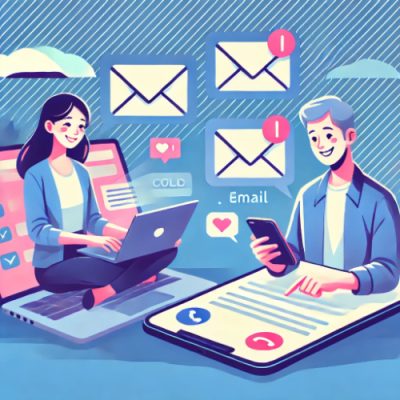When it comes to cold email open rates, there’s a lot of noise and a wide range of what’s considered average or good. A
According to my research and findings from cold email companies conducting their own studies, the average cold email open rate falls between 20% and 70% (sources provided below).
That’s a significant range for an average cold email open rate, and it doesn’t give us much clarity on what is truly average or good.
Then, there are Redditors who share their own experiences and campaign successes, with the average cold email response rate ranging between 15% and 50%.
Slightly better, but still, the range is too wide!
Lastly, I want to share my own average cold email open rate, which falls between 37.1% and 48.1%:
| Campaign | Open Rate | # of Prospects |
| 1 | 42.3% | 2,886 |
| 2 | 37.1% | 4,167 |
| 3 | 43% | 1,694 |
| 4 | 41.9% | 1,125 |
| 5 | 48.3% | 532 |
| 6 | 44.4% | 583 |
So with all this, let’s answer the following questions:
What is the Average Cold Email Open Rate?
Based on research from companies, recommendations from Redditors, and my own campaigns, the average cold email open rate is between 30% and 40%.
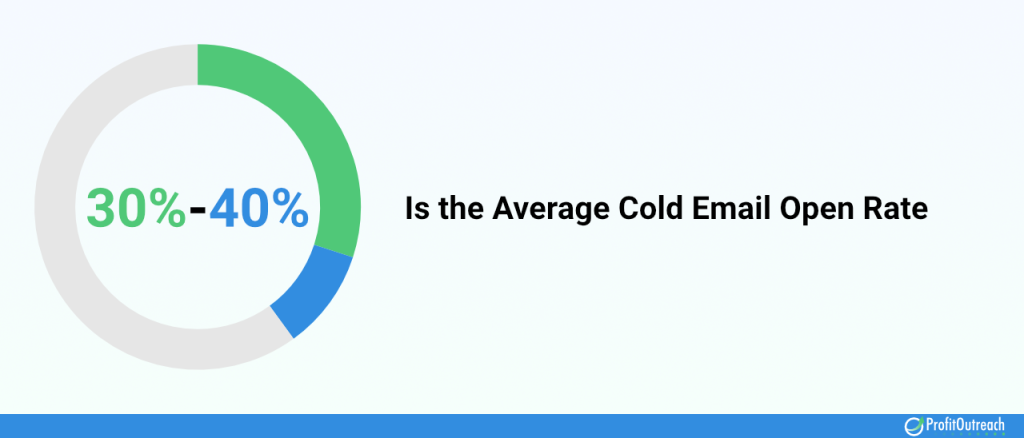
Therefore anything below we can assume that anything below this means you did not apply the cold email best practices such as the quality of the email list, the relevance of the content to the target audience, the effectiveness of the subject line, and much more!
However, it’s important to remember that averages can vary widely depending on the industry, the nature of the outreach, and the level of personalization involved.
While a 30-40% open rate is a solid benchmark, higher rates are achievable with cold email campaigns, hyper-personalization, and proper targeting and segmentation.
What is a Good Cold Email Open Rate?
A good cold email open rate is one that exceeds the average and signals that your outreach is resonating with your audience. Generally, if you’re seeing an open rate above 40%, you’re on the right track.

However, this isn’t a one-size-fits-all number.
A “good” open rate can vary depending on your industry, your audience, and how well you’ve crafted your email.
For example, if you’re targeting a highly specific group with personalized content, you might aim for an open rate closer to 50% or even higher. Such as this research where they had a 70% cold email open rate.
The key is to consistently track your performance and compare it to past campaigns.
If you notice a steady increase, you’re doing something right. On the other hand, if your open rates are stagnating or dropping, it’s time to revisit your strategy.
How to Calculate Cold Email Open Rate?
To calculate your cold email open rate here’s the formula:
Open Rate = (Emails Opened / Emails Delivered) * 100
As you can see, calculating your cold email open rate is straightforward and essential for understanding how well your emails are performing.
To calculate it, you simply take the number of emails that were opened and divide it by the number of emails that were successfully delivered, then multiply by 100 to get a percentage.
For example, let’s say you sent out 1,000 cold emails, and 750 of them were successfully delivered to the recipient’s inboxes. Out of those, 300 emails were opened. Your calculation would look like this:
Open Rate = (300 / 750) * 100 = 40%
This means 40% of the recipients opened your email, which is a solid open rate. Tracking this metric helps you gauge the effectiveness of your subject lines, timing, and overall strategy.
6 Factors Affecting Cold Email Open Rates
Now that we know what cold email open rate we’re aiming for, the next thing we need to focus on is what actually affects your cold email open rates.
And there are 6 main factors affecting cold email open rates and with that your success in cold emailing:
Subject Lines
The subject line is the bold text that appears after the email sender’s name. It remains bold until the email is opened; once opened, it will no longer be bold.

This placement is very prominent and one of the first things users notice. It’s no surprise that 64% of recipients decide to open or delete emails based solely on the subject line, and 69% of email recipients will report spam based on the subject line.
That’s why your cold email subject line needs to be top-notch! Personally, I spend more time crafting the right subject line than I do on the email copy itself!
Want to learn how to write a killer cold email subject line? Check out my article!
Sender Name & Email Address
Another important factor that’s affecting your cold email open rate is the sender’s name and email address!
According to a study, 45.90% of emails are opened because of the sender’s name.
This is understandable as unrecognizable names or fake-sounding names instantly spark alarm in the recipient’s brain “Fake” or “Scam”.
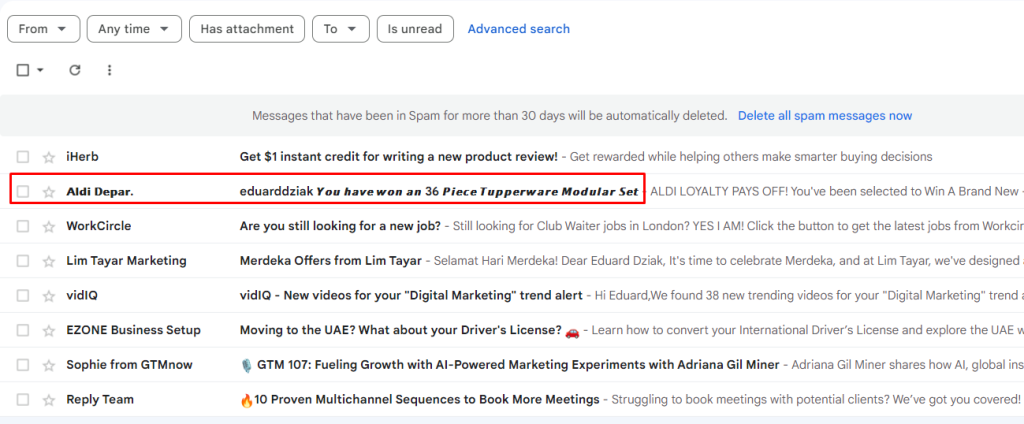
People are more likely to open emails from a sender they recognize and trust or at least from senders with “real” sounding names.
Furthermore, users prefer to open emails sent by a person instead of a company.
So, make sure your sender name is clear and professional, and avoid using generic email addresses like “[email protected].” Instead, use a real person’s name or your company’s name to build trust.
And I am not even talking about the higher chance of ending up in the spam folder!
Sender & Domain Reputation
When it comes to sender, domain, and even IP reputation, the topic can get very technical, and many factors can affect it, such as spam complaint rates, spam traps, using spammy keywords, blasting too many emails at once, engagement rates, and more.
Therefore, to ensure a high cold email deliverability rate, your reputation needs to be in excellent shape! There are many tools you can use to check your reputation, such as Sender Score, Barracuda Central, Postmaster Tools, and many others!
Personalization
Cold email personalization has been proven by many studies to be an important factor in cold email open rates.
For example, a study by AIRI achieved a 70% open rate by using personalization! When the personalization elements were removed, the open rate dropped significantly to only 17%.
Therefore, applying cold email personalization best practices is crucial for your cold email open rates!
But more on this later!
Timing & Frequency
Another major factor in cold email open rates is the timing and frequency of your cold email sequence.
Simply put, when you send your cold emails matters!
Numerous cold email statistics prove that timing is essential.
For instance, one study indicates that Monday and Tuesday are the best days to send cold emails, while emails sent on Wednesday and Thursday also perform well, albeit slightly less effectively.
Furthermore, cold emails sent at 1 p.m. have the best chance of receiving replies, with the next most effective time being 11 a.m.
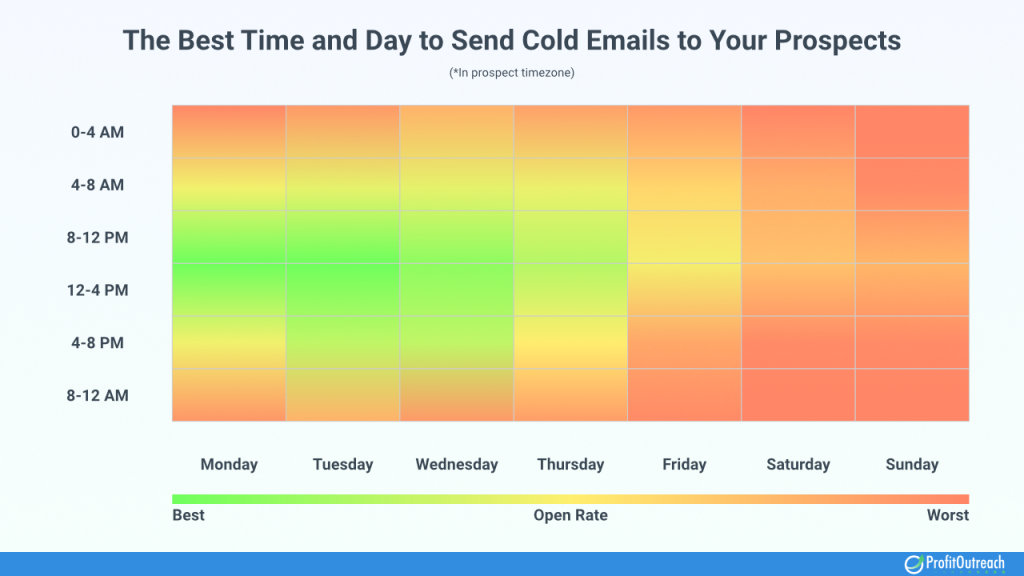
It’s crucial to send your cold emails when your prospects are most likely working, essentially during their office hours!
However, with globalization, this can be a bit tricky, as your time zone might differ from your prospects’, but smart outreach tools can easily handle this!
Additionally, if you’re sending more than 100 emails a day, you will need to spread out your cold emails, even during less effective times.
Otherwise, you risk ending up in the spam folder by sending too many emails at once!
Again, smart cold email software can manage the spacing of your cold emails for you.
Relevance & Targeting
And last, but definitely not least, is the relevance of your messaging and your target audience.
If your email content isn’t relevant to the recipient, it won’t matter how good your subject line is—they won’t open it, let alone take action. That’s why it’s so important to do proper research on your potential target audience:
- What companies are the best to target?
- What departments and roles should you target?
- What are their challenges, needs, and motivations that would make them interested in what you’re offering?
- What is your USP and value proposition?
- How will you deliver your message?
If you want your cold emails to be opened, you need to nail down all of this!
If you understand the industry, your prospects, and the problems you solve for them, you’ll be able to phrase your messaging in a way that makes it a no-brainer for your prospects to reply and learn more from you.
Segment your email list to target specific groups with content that’s directly relevant to them. The more targeted your approach, the higher your open rates will be.
How to Improve Cold Email Open Rates? (12 Best Tips)
As you can see, cold email open rate is essential for your success in cold email and luckily, there are many tips and tricks to get it above average and beyond.
Here are my cold email open rate best practices that work every time!
Personalize Your Subject Line
Personalization is no longer the cool word that you can throw around, but not really do it.
When you include the recipient’s name or something specific about their business in the subject line, you’re more likely to catch their attention.
Personalizing your subject lines it’s an essential cold email strategy to improve your open rates.
In fact, according to the klenty research, personalized cold email subject lines have 2x higher open rates.
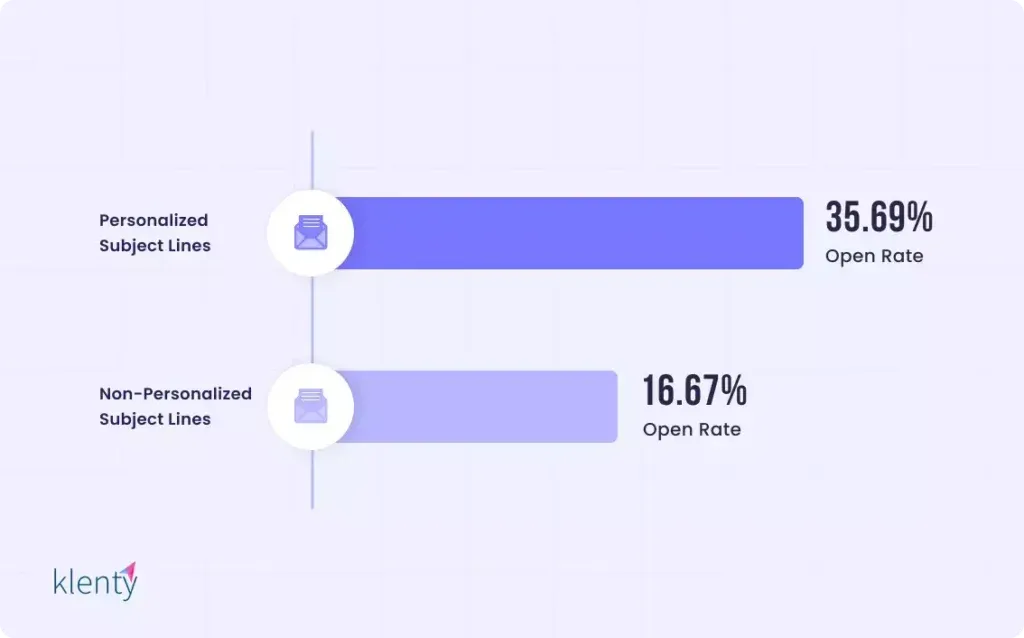
Another research shows that cold emails with personalized subject lines generate 50% higher open rates.
For example, instead of using a generic subject line like “Grow Your Business with Us” try “John, Boost Your Sales by 30%”

Notice how the personalized name and tailored message make the email feel more relevant.
Implement Subject Line Best Practices
Now, it’s not only about implementing personalized cold email subject lines but also about applying some of the proven subject line best practices.
For example, studies have shown that cold email open rates are the highest when the word count is between one to five.
Or email subject lines that evoked urgency boosted the open rates by 22% on average.
Studies show that subject lines with 6-10 words have the highest open rates.
Many more statistics show that using different types of subject lines with urgency, curiosity, personalization, and more can boost your open rate.
For example, instead of saying “Amazing Deal Inside! Open Now,” opt for “Limited-Time Offer: Save 20% on Your Next Purchase.” This approach is direct and enticing without sounding like spam.
Therefore, search for email and cold email subject line statistics and try some of these for your own use.
Implement Cold Email Deliverability Best Practices
Even the best email won’t be opened if it lands in the spam folder.
In fact, according to ReturnPath, 20% of emails fail to reach the recipient’s inbox.
As I said, this topic can get very technical, but there are many easy ways to boost your cold email deliverability rate such as using reputable email services (Google or Microsoft), avoiding sending too many emails at once, starting slowly with 5-10 emails per day, personalized and target your cold emails as the second most common reason for inbox placement issues is spam complaints, and avoid too many “spam” words usage in your cold email copy.
All this and more are totally in your control and can make a huge impact on your deliverability and ultimately on your cold email open rates!
Edit the Preview text
Your email’s preview text is like an extension of your subject line, offering a sneak peek at what’s inside giving you a chance to punch to most value to your prospects.
So, just like with the subject line, you should utilize this space to reinforce the subject line and add extra incentive to open your email.
Emails with optimized preview text can see open rates increase by up to 30% as 24% of email recipients read the preview text before opening your cold emails.
For instance, if your cold email subject line is “Increase Your Sales by 30%,” your preview text might read, “See how our strategy helped companies like yours boost revenue—let’s discuss.”
This combination highlights a specific benefit and teases valuable content, making the recipient more likely to open the email.
A/B Test
First of all, never assume you know what works best—test it!
A/B testing allows you to compare two versions of your email to see which one performs better. This could be different subject lines, types of emails, preview texts, or even sending times.
A/B testing is one of the most basic marketing strategies out there, yet, it’s also considered the holy grail of boosting open rates, conversions, and revenue for your business!
In fact, marketers who test their campaigns see a 60% higher return on investment. A/B testing can help identify the most effective copy creatives, leading to a 40% increase in click-through rates. A/B testing can help improve email click-through rates by 30%. (Source)
So, saying that A/B testing is a game-changer is still an understatement!
And you should have regular A/B testing running for your cold emails!
For example, you might test “New Strategies for Your Marketing Plan” against “How to Improve Your Marketing ROI by 50%.” By tracking which subject line performs better, you can optimize future emails for higher open rates.
Consider implementing spintax technology in your A/B tests to efficiently create multiple message variants that can be tested simultaneously.
Send Cold Emails to Only Business Personal Email Accounts
Personal emails are meant only for personal use, so bothering people on their personal email accounts can reflect negatively on you and your brand.
More importantly, personal email accounts are often subject to stricter compliance and regulation, which can result in your emails ending up in spam folders more frequently and damaging your domain reputation.
Additionally, sending emails to generic addresses like “[email protected]” often leads to your message being overlooked or ignored.

The biggest advantage of cold emailing and outreach is the ability to directly reach decision-makers!
So, why waste your cold email quota on generic, ineffective business emails?
Instead, target business personal email accounts, such as “[email protected],” to increase the chances of your email being seen and opened by the right person.
Research Your Target Audience
Research is probably the most important part of your cold email strategy, as it provides you with the exact talking points for your emails!
Proper target audience research will help you understand:
- Their problems and challenges
- Their motivations for making a purchase decision
- Their specific needs
- How to position yourself and your messaging
- What information do you need to provide to convert prospects into customers
It gives you everything you need to know about your prospects to write effective and profitable cold email sequences!
Remember, personalization isn’t just about using your prospect’s name, job title, or company name, nor even mentioning what they said last week on LinkedIn.
It’s about understanding what keeps them up at night and positioning your solution as the remedy.
Trust me, if you do this, your cold emails will deliver far better results, even if you don’t mention their name, job title, or company within the emails.
However, you should still include these details—they’re low-effort and make your emails slightly more credible, but they’re not decisive. Not even close. So don’t stop there.
Use a Professional Email Address
Another important best practice to improve your cold email open rates is to use a real professional email address.
Your sender’s email address plays a significant role in whether your email gets opened. Using a professional, recognizable email address rather than a free or obscure one can build trust and credibility.
For example, an email from “[email protected]” is more likely to be opened than one from [email protected].

We all receive those spammy messages from strange Gmail addresses out of nowhere, and we all avoid opening them!
I also recommend using your real name, as it helps to build trust and allows prospects to potentially research you, validating you, your business, and your offer.
If prospects want to learn more about you but can’t find any information, they are less likely to respond—or worse, they might report you as spam!
Redirect Your Cold Email Domains to Your Main Domain
To protect your primary domain’s reputation while still ensuring recipients recognize your brand, use a separate domain for cold emailing, but set it to redirect to your main website.
This strategy helps manage your sender reputation while maintaining brand consistency.
For example, if your main domain is “yourcompany.com,” you could send emails from “yourcompany-email.com” and have them redirect to your main site.

This helps maintain trust while managing deliverability.
Send Your Cold Emails at the Right Time
As I mentioned earlier, timing can significantly impact your cold email open rates. Research suggests that cold emails sent on Tuesday and Thursday mornings tend to have higher open rates.
However, it’s important to consider your audience’s specific time zone and work habits.
For example, I learned that sending emails to warehouse managers in the morning is not as effective because they spend that time in the warehouse doing work and only come to the office later in the afternoon to handle administrative tasks.
Another limitation is the number of cold emails you can send.
You cannot simply send all your emails at once, say at 1 PM on a Monday or Tuesday, as that would quickly lead to a burnt domain.
Instead, your best option is to schedule your cold emails to be sent between 9 AM and 4 PM.
Most cold email software will then randomize the sending times and introduce delays between emails to mimic the natural style of a salesperson sending cold emails.
However, make sure you also experiment with different times and track your results to find what works best for your audience.
Address Their Needs or Pain Points
One of the essential ways to get a prospect’s attention is to address their needs or pain points in your subject line, preview text, and within the content itself.
You must remember that prospects only care about themselves. They don’t care about your company, your achievements, or your story until you show them there is something in it for them.
The only way to show this is by being the solution to their problems and needs. It’s the only way to get a prospect’s attention in a cold email.
That’s why researching your target audience and identifying their common—and even less common—challenges, then addressing those in your cold emails, will pique your prospect’s interest!
So, do this:
- Identify the pain points of your target audience and address them in your cold emails.
- Explain solutions and demonstrate how your product or service can solve their problems.
- Personalize your cold emails with their names, job titles, company names, and perhaps some observations from their LinkedIn posts.
- Empathize with them by understanding how their challenges make their work difficult.
- Offer value and a solution to their challenges and needs.
Do this correctly, and you’ll have a recipe for many responses! Not easy, but worth it!
Have an Optimal Number of Follow-Ups
A cold email follow-up is any subsequent cold email sent after the initial outreach to a potential client or contact.

Follow-ups are crucial in cold emailing because not everyone will open or respond to your initial message.
In fact, if you send up to 10 follow-ups, your total reply rate can reach as high as 22.37%.

However, finding the right balance is key.
Typically, sending 3-5 follow-up emails is considered optimal, and each should provide additional value or a new angle to your offer. Spacing them out over a few days or a week is usually effective.
If you want to craft personalized cold email sequences, try ProfitOutreach!
We use prospect’s personal and professional data from their LinkedIn profile, website, and spreadsheet you provide as well as information from you and your offer.
All this information is then processed and we will craft hyper-personalized cold email sequences for you.
You can build your own cold email sequence by just selecting cold email templates.
What is the Cold Email Open Rate?
The cold email open rate is a key metric that measures the percentage of recipients who open your cold email out of the total number of emails successfully delivered.
This metric is crucial because it indicates how effective your email subject lines, sender name, and overall email strategy are at grabbing the attention of your target audience.
Why is Cold Email Open Rate Important?
Cold email open rate is important because it measures how well your cold emails resonate with your target audience.
If you have a good or excellent cold email open rate it means, your subject line, preview text, timing, and other factors are properly set up.
On the other hand, if your cold email open rate is bad it means you have some work to do on your target audience research, subject lines, preview text, timing, and other factors.
However, as ESPs are getting stricter with tracking cold email open rates, it’s harder to measure this. Therefore it’s important to track other metrics and ultimately have properly set up conversions so you track what matters the most, revenue!
How ProfitOutreach Can Improve Your Open Rates?
ProfitOutreach can improve your open rates by enabling you to craft highly personalized cold email sequences that resonate with your target audience. It offers precision personalization, allowing you to tailor subject lines and content based on real prospect data.
FAQs about Cold Email Open Rate
In this section I am going to answer FAQs about cold email open rates:
What is the 30/30/50 rule for cold emails?
The 30/30/50 rule for cold emails suggests that 30% of your success comes from targeting the right audience, 30% from crafting compelling content, and 50% from following up effectively. This rule emphasizes the importance of audience targeting, message quality, and persistence in cold email campaigns.
What is a good cold email response rate?
A good cold email response rate typically ranges between 10% and 20%. Higher response rates indicate that your message resonates with your audience, while lower rates may suggest a need for improved targeting or content.
Is a 50% open rate good for cold emails?
Yes, a 50% open rate for cold emails is considered very good. It indicates that your subject lines and preview text are effectively capturing the attention of your recipients, leading to higher engagement with your email content.
Is a 20% cold email open rate good?
A 20% cold email open rate is considered average. While it’s not bad, it suggests there’s room for improvement. Optimizing subject lines, personalization, and timing can help boost your open rates above the average benchmark.
How do I increase open rates on cold emails?
To increase cold email open rates, focus on personalizing subject lines, using a recognizable sender name, optimizing email timing, and A/B testing different subject lines. Additionally, ensuring your email list is well-targeted and avoiding spammy language can significantly improve open rates.
What is a bad cold email open rate?
A cold email open rate below 15% is generally considered bad. It indicates that your emails aren’t resonating with your audience, possibly due to poor subject lines, irrelevant content, or issues with email deliverability.
How do I maximize email open rates?
To maximize email open rates, use personalized and compelling subject lines, optimize the sender name for recognition, and send emails at peak times for your audience. Regularly clean your email list to ensure it’s targeted and avoid spammy language. Implement
Related Articles
- Ultimate SaaS Cold Email Strategy to Grow Your MRR
- Best Cold Email Opening Lines and How to Write Them
- Cold Email Copywriting Ultimate Guide: Tips & Best Practices
Related Cold Email Templates
- Final Follow-Up Cold Email Template Guide: Examples, Best Practices, and Tips
- Follow-Up Cold Email Template Guide: Examples, Best Practices, and Tips
- Partnership Cold Email Template Guide: Examples, Best Practices, and Tips
Related Cold Email Sequences
- How to Create Effective Partnership Cold Email Sequence for Bigger Growth
- How to Create Effective Service Cold Email Sequence to Get More Clients
- Boost Open & Conversion Rates with Special Offer Cold Email Sequences
